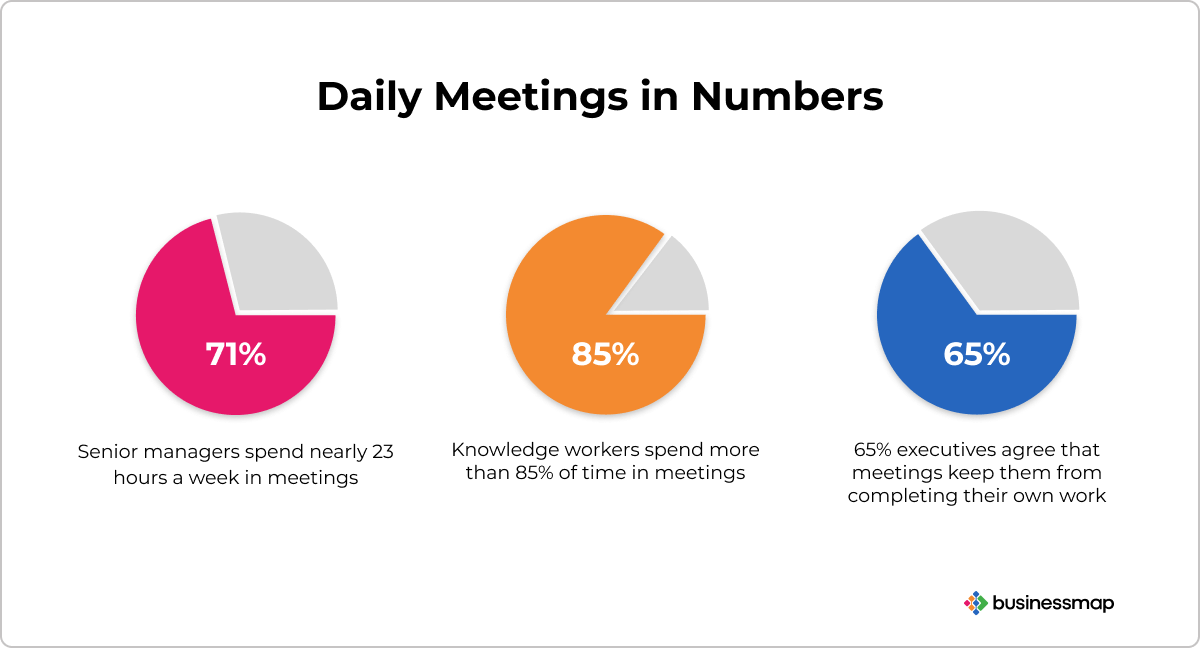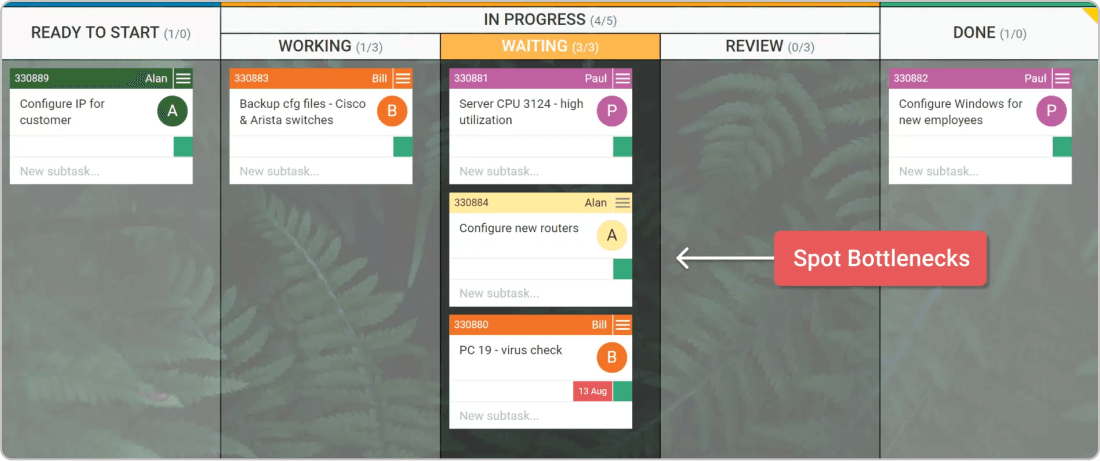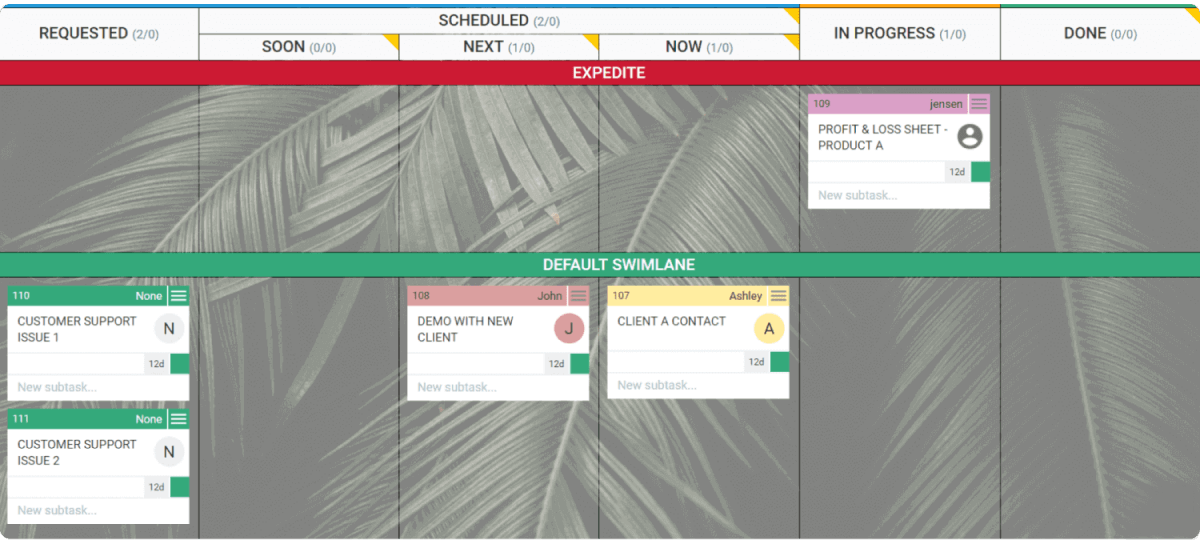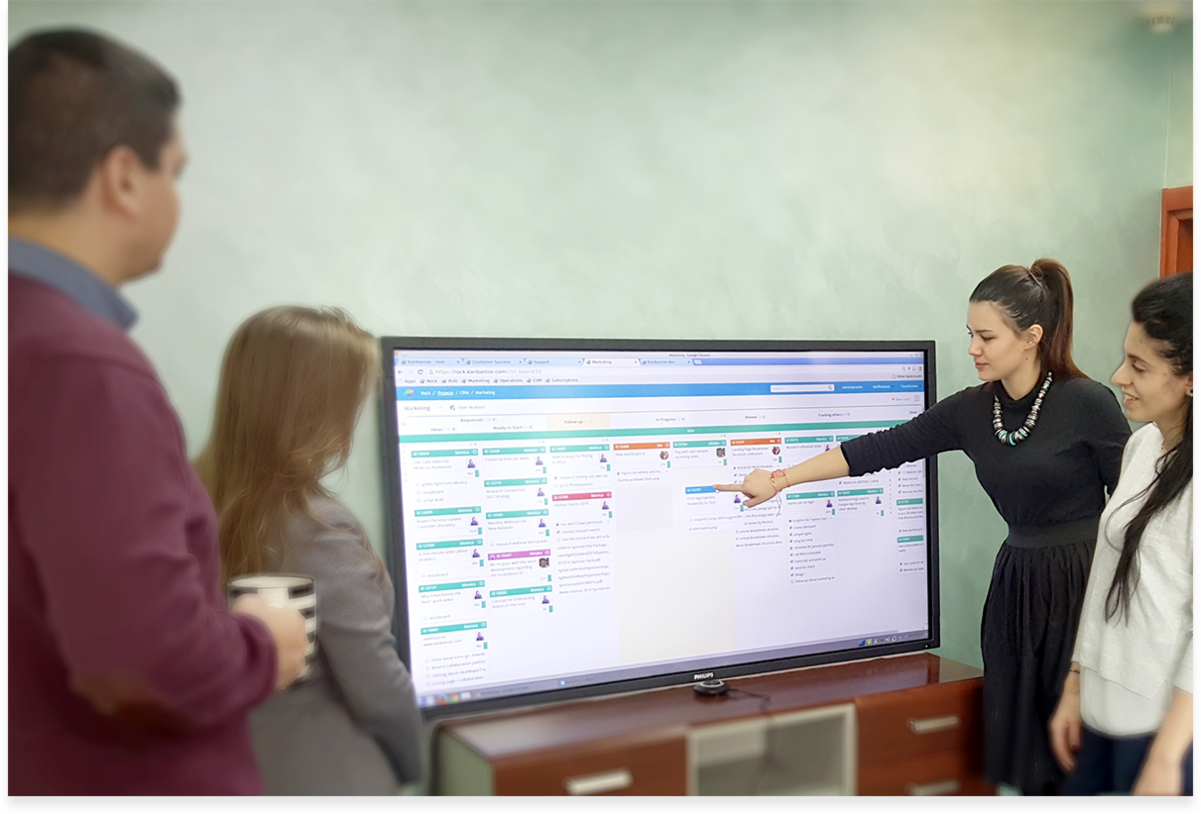Stand-up meetings have become a sacred ritual for teams using Agile in any form. They are fantastic for keeping a company aligned and focused in the same direction. Although implementing them is not difficult, making the most of these Agile daily standups with your colleagues requires practice and, nonetheless, experimentation.
Over the past decade, we've accumulated a wealth of experience in this area. It's only right that we share our insights and offer stand-up meeting best practices and successful strategies that have worked particularly well for us.
Stick to the end to:
- Learn what a stand-up meeting is and what makes it important;
- Get some proven tips for enhancing them;
- Review a few mistakes that you must avoid at all costs;
- The benefits your team will see.
What Is a Stand-up Meeting?
In Agile, a daily stand-up meeting, also known as a "standing meeting," is a brief gathering where team members, typically standing, discuss work progress such as completed, ongoing work, and upcoming projects, and identify work blockers.
It is also known as daily stand-up or daily kanban for teams practicing the Kanban method, due to the recurring cadence of the meeting.
Initially, the daily stand-up meetings originated in Scrum but were quickly adopted by teams using various Agile frameworks and methods.
They are very typical for software development teams but are gaining popularity in other fields of work, such as marketing, project management, product development, and many others. This is because holding a short stand-up meeting provides a fresh and, most of all, effective alternative to typical round-table meetings that are dreaded by a large portion of the current workforce.
In fact, research by Harvard Business Review shows that meetings have increased in length and frequency over the past 50 years to the point where executives spend an average of nearly 23 hours a week in them, up from less than 10 hours in the 1960s.
The problem, however, is not only with the length of these meetings but also with the fact that they can easily go off course, even if there is a solid agenda set upfront. This results in wasting time and energy and, nonetheless, reduced workflow capacity.
 Sources: HBR and MIT Sloan Management Review
Sources: HBR and MIT Sloan Management Review
Eight Tips to Run Efficient Stand-up Meetings that Teams Will Love
Stand-up meetings are a streamlined alternative to traditional round-up gatherings, emphasizing focus, brevity, and efficiency. Here are eight tips to make your stand-up meetings as effective as possible and respectful of your fellow team members.
Tip 1: Pick a Recurring Time and Stick to It
To begin with, select a recurring time for the daily stand-up meeting that is convenient for each person who is supposed to attend. We advise you to schedule it soon after the beginning of the workday. This will allow you to sync your plan for the day and avoid mistakes caused by a lack of communication.
Tip 2: Aim for a 10-Minutes Stand-up
To give it a specific time frame, we advise you to aim for 10 minutes, but anything between 5 and 15 minutes is perfectly fine.
Tip 3: Choose a Stand-up Meeting Format
At the beginning of the meeting, gather around your kanban board. Here you need to understand that there are two common approaches to the stand-up meeting format widely adopted along various Agile methodologies:
- Focusing on the process
- Focusing on the people
If you want to focus on the team during the daily meeting, each person, with no exception, must be able to answer three fundamental questions regarding their workflow:
- What did I accomplish yesterday?
- What will I do today?
- What obstacles, if any, are impeding my progress?
Note that this method of holding a stand-up meeting is effective for teams that are not visualizing their workflow. Explaining what you did the previous day is not necessary in the presence of a work management board, as each task's assignee is visible, and that would reduce the value of the meeting.
If you choose the process-focused approach to a daily stand-up, you need to pay attention not so much to what was done the previous day but rather to what's slowing down items that have been in progress for the longest amount of time. Put special attention to blocked work and discuss how you can deal with any progress impediments. You might even take action to tighten the work-in-progress (WIP) limits in your process to reduce context switching.
Tip 4: Focus on the Process
Emphasizing the process over individuals in daily stand-up meetings will help you ensure the team's efforts are directed towards tangible progress rather than merely accounting for time spent. This distinction is vital as being busy doesn't necessarily equate to being productive. By concentrating on the processes and the tasks at hand, teams can more effectively identify and address bottlenecks, improve workflows, and ultimately achieve their goals. This approach fosters a more results-oriented culture that values achievement and efficiency over mere activity.
 Using WIP limits to identify process bottlenecks on a project management board in Businessmap
Using WIP limits to identify process bottlenecks on a project management board in Businessmap
Tip 5: Participation Is Required for Everyone
Ensuring full participation in daily stand-up meetings is crucial, including from remote employees who may be located anywhere in the world. Teams need to equip remote employees with the proper tools and access to stay engaged. This inclusivity underlines the importance of selecting a meeting time that accommodates everyone. By doing so, you foster a collaborative environment where each member feels valued and integral to the team. This will lead to improved communication and unity within the team but also ensure that insights and updates are shared comprehensively, making the stand-up meetings even more effective.
Tip 6: Be Punctual
Everybody must understand that the stand-up meeting doesn't wait for anyone. For example, if you schedule it for 9:15 am, you should start at this very minute. Do not tolerate being late, and develop a stimulus mechanism to motivate your team to be on time.
A while ago, we changed the time of the marketing team's daily stand-up. Because it was moved 20 minutes ahead, a problem quickly arose. For a couple of weeks, somebody entered the meeting late every day.
This caused tension among the team, so we decided to take a rather drastic measure to fix the problem. We agreed that whenever somebody comes in late, the meeting will be moved one minute ahead permanently.
Although you may think this is quite harsh, it brought immediate results. Nobody wanted the stand-up to start earlier, and nobody wanted to harm the rest of the team. Since this measure was taken, we've moved our daily stand-up just 2 minutes ahead.
Another less stressful stimulus would be for the person who's late to buy coffee for the whole team the next day or do something else in everybody's favor to make up for not arriving on time.
Here it is important to say that you risk creating a safe environment for being late if the team thinks that they can buy their way out of being punctual. The best you can do is try to find a balance between the carrot and the stick.
Tip 7: Determine the Order of Speaking
To begin with, you need to determine who starts speaking first. A commonly adopted practice is for the last person entering the meeting to have the honor.
In case this seems a little rough, you can start presenting clockwise or counterclockwise using the board as the 12 o'clock indicator. And, of course, you may just keep this unregulated and allow anyone to start the meeting.
There are quite a few stand-up best practices and ideas to determine the order of speaking at the meeting, including:
- Round robin: the next person on the left/right has to continue;
- Passing the baton: the person who is done presenting passes a sacred item (before the pandemic, we used a plush hedgehog) to a teammate of their choice, and that person has to continue;
- Workflow state: go over the board and start with the kanban cards furthest to the right, which are usually done or close to being finished. Respectively each card's owner must talk about it.
Each of these stand-up ideas is viable, although if the people participating are nearing 10 people or even surpassing this number, passing the baton might not be a wise choice because somebody may easily be forgotten. Also, we would like to stress that the third option is by far the most valuable to Kanban practitioners.
Tip 8: Avoid Hijacking the Meeting
Once the stand-up meeting is over, team members involved in interconnected work or sharing dependencies should have a detailed discussion to avoid dominating the entire daily meeting. This strategy respects the meeting's time constraints and allows for more efficient use of the stand-up by covering a broad overview of progress and blockers. Detailed discussions among relevant team members can then address specific challenges or topics without compromising the stand-up's streamlined nature.
What Are the Five Stand-up Meeting Practices We Use Today?
If you put into practice everything you've read about to this point in the article, you will see an immediate positive effect from your daily stand-up meeting. The following paragraphs contain stand-up ideas that we've implemented at some point in Businessmap and that have enhanced our value.
1. Scheduling the Meeting at an Unusual Time
When scheduling the daily meeting, it is a good idea to choose an unconventional time. For example, our RnD team meets at 9:18 AM, marketing at 9:52, customer support at 10:08, etc.
This practice makes the meeting more memorable. Even better, when preparing to apply this Agile ceremony for the first time, allow your team to suggest a time for the meeting.
2. Raising the Alarm Using Notifications
At the very beginning of my journey at Businessmap, the marketing team had an alarm that started ringing a minute before the actual time of the stand-up. To give the stand-up meeting a positive connotation, we suggest you choose either a cheerful tone/song or some iconic music from a movie. A good example would be Queen's all-time hit "We Will Rock You".
Another way to put this stand-up idea into practice is to set up a calendar notification to pop up just before the meeting.
Even better, an alarm should be set up to indicate that 15 minutes have passed since the start of the meeting. This will serve as a timekeeper and help you present information more concisely during the stand-up.
3. Gathering Small Teams (3 to 8 People)
Running a 10-minute daily meeting with 15 people would be quite the challenge, and you would have a hard time getting any value out of it. Keep your meetings focused based on activity and break them down whenever a team grows too large.
When we were outgrowing the startup level, we drastically expanded our business unit. By that moment, our marketing, sales, and customer success teams were gathering for a joint stand-up. With a growing number of people attending, the efficiency of the daily meeting dropped significantly.
Soon after, we broke it down into two separate meetings and the situation changed immediately for the better. Since then we've done numerous experiments, sometimes even mixing teams based on specific projects that we were doing.
Of course, everybody is welcome to these meetings as a spectator when they want to learn what another team is doing, but they need to keep their questions for the end of the meeting.
4. Starting with a Physical Activity and Remote Inclusion
Nothing can get you as pumped up for the day ahead as an actual pump. This stand-up idea was picked up by our founders, who always start their daily stand-up meeting with a set of 20 pushups before going over their strategic portfolio management board, which contains the company-wide plans and initiatives.
We suggest you choose some easy exercises like jumping jacks or squats and keep in mind your team's shape when selecting the number of reps they should do.
For geographically dispersed teams, use video conferencing or collaborative online tools to ensure everyone feels involved and can contribute their updates during the stand-up.
5. Acknowledging the Highest Priority First
When starting the stand-up, we've found out that the best way to keep the team looking in the same direction is to discuss the items with the highest priority first. Our workflow boards are split into two types of workflows:
- Team initiatives
- Work execution
Shortly explained, team initiatives represent projects or Agile epics, which are then broken down into multiple work items and linked together. When holding the meeting, we always talk about the initiatives and only mention individual tasks that we've done if they're not linked to an initiative but were with higher priority.
A good example would be when expedited work arrives on our development team's board, and they have to leave anything else to fix the problem as soon as possible.
 Visualizing work with the highest priority using "expedite" swimlane on a work management board in Businessmap
Visualizing work with the highest priority using "expedite" swimlane on a work management board in Businessmap
By going only through the initiatives, you will be able to stay up to date with progress on the truly important activities and not get distracted by insignificant personal tasks, which are an inevitable part of the workday.
The 4 Mistakes to Avoid For an Effective Stand-up Meeting
So far, we have covered plenty of good practices, but of course, there are ones that you'd better avoid if you want to have a positive experience from your daily stand-up meeting.
1. Don't Turn It into a Status Report
This is by far the most significant mistake you can make. Your goal is to keep the team aligned, not report status to whoever's in charge in the room (executive, manager, lead, etc.).
Avoid detailed explanations about each task and stop team members that do so, in a polite way, of course.
2. Give the Daily Stand-Up Meeting a Positive Connotation
At first, stand-ups may seem intimidating, especially for introverted people.
Even though team members should be comfortable talking to each other, when discussing their work publicly with the whole team, including the manager, some people can become nervous.
Avoid judging and giving negative feedback publicly during the meeting. Remember, positive feedback has the greatest effect when given in front of everyone, but negative feedback can greatly harm people's reputation, morale, and self-confidence in the same situation.
3. Avoid Sharing Non-Relevant Information
As discussed, daily stand-up meetings are successful if teammates engage in a discussion after the meeting, not during. Any questions or problems that need a more profound investigation and are unrelated to most participants should be further discussed afterward. Going into discussions that do not concern the entire team increases the chances of losing teammates' focus and missing essential updates.
4. Sitting Down
Last but not least, everyone working from their offices should remember why the meeting is called a stand-up. It's not uncommon for some teams to actually hold their stand-ups while sitting down comfortably around a table.
This is a mistake because you lose one of the most important advantages of stand-up meetings - the fact that they are short and on point, so team members can quickly go back to their actual work without switching context.
Remember why you are switching to this type of daily meeting, and if necessary, remove all the chairs from the room where you are gathering each day.
What Are the Benefits of Holding a Daily Stand-Up Meeting?
By applying the tips from this article to your stand-up meetings, your team can experience the full range of benefits these daily gatherings offer.
- Workload Alignment and Transparency: Keeping everyone in the loop is essential for the success of the work being done and for delivering the value your clients deserve. Thanks to the daily stand-up meeting, your teammates can sync work progress and any updates that will affect the course of the work while being on track with the company's objectives and strategic goals.
- Easier Work Roadblocks Identification: Stand-up meetings are ideal for addressing any obstacles that are blocking the progress of the work. It is during that time that potential solutions are discussed, and everyone should feel open to sharing any ideas.
- Better Teamwork and Collaboration: This 5- to 15-minute team gathering is crucial for building a cohesive team. It is even more important for remote teams and team members who may feel disconnected from the rest of the company. Beyond sharing work-related news, these meetings improve teams' connection and work efficiency.
- Respond to Changes Faster: Regular stand-up meetings enable team members to update on their work and stay informed about any unforeseen project developments, facilitating swift adaptation to new conditions without disrupting workflow.
Stand-up Meeting Frequently Asked Questions (FAQ)
1. What Is a Stand-up Meeting in Agile?
In Agile, a stand-up meeting is a short meeting between team members who gather daily to discuss the most critical current business matters. It is required that this meeting be no longer than 15 minutes and held standing up in front of a visual work board.
2. What Is the Purpose of a Stand-up Meeting?
The goal of running a stand-up meeting is to review the work that has been finished, is still in progress, or is about to be started. The practice helps to address any impediments in the process and finds potential ways to overcome them, as well as new opportunities for work improvements. Furthermore, meeting daily improves team collaboration, affecting the team's overall performance and work efficiency.
3. What Is a Scrum Meeting vs. Stand-up?
By Scrum meeting, we refer to various meetings a Scrum team holds, including the daily stand-up meeting. In practice, it's almost the same as the Daily Kanban meeting. The only difference is that a Scrum Master facilitates the meeting, and each team member should be able to answer these questions:
"What did I do yesterday?"
"What am I going to do today?"
"Is there something blocking my progress?"
In Conclusion
The stand-up meeting is one of the most popular and widely spread Agile practices. It can help you achieve better alignment between your teammates and keep everyone focused in the same direction.
Stand-up meetings can provide relief from the long round-table gatherings with questionable value and improve communication across your whole company. Although they might seem quite simple to implement, there's a lot more to them than meets the eye.

Pavel Naydenov
Marketing Professional | Kanban & PPM Ops Certified
Pavel is a natural-born optimist with 10+ years of experience in the marketing field. By leveraging Kanban, Lean, and Agile practices for years, he drives brand growth and engagement through data-driven marketing strategies. He believes every message should express the fundamental values of a brand, and if delivered positively, it can change the course of its existence.




